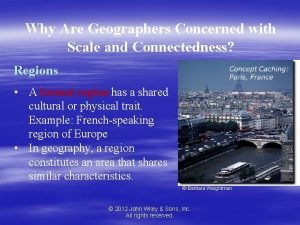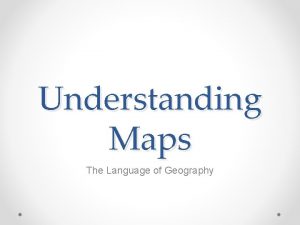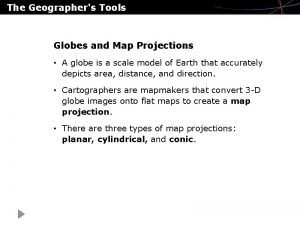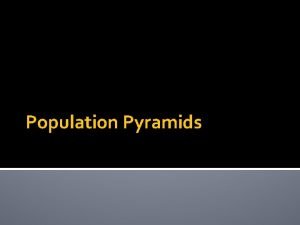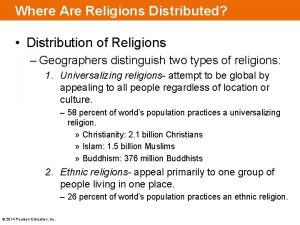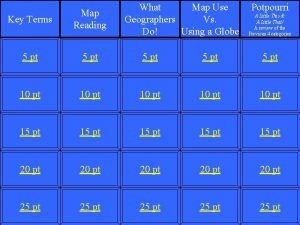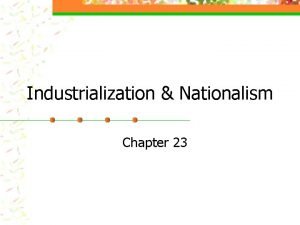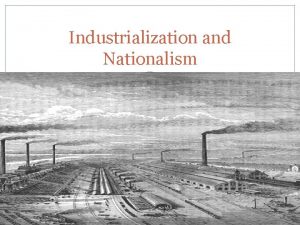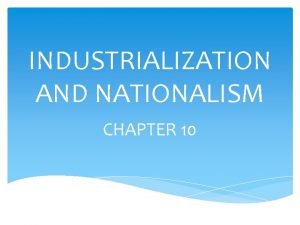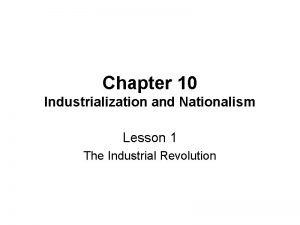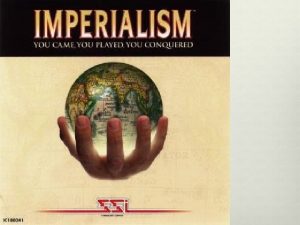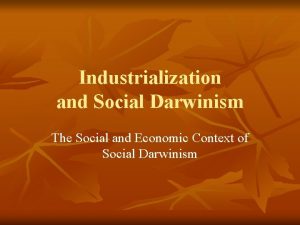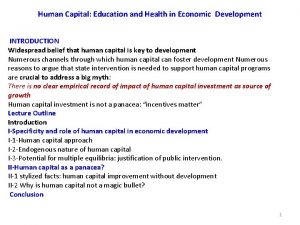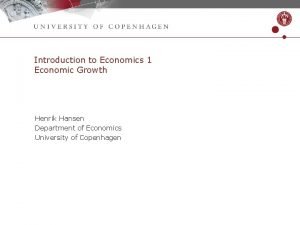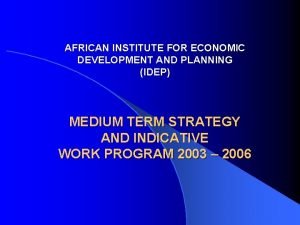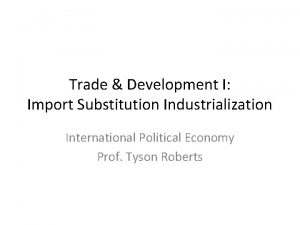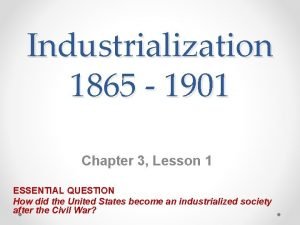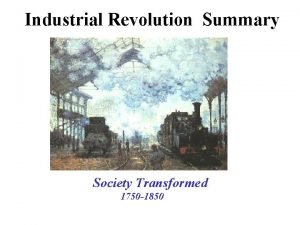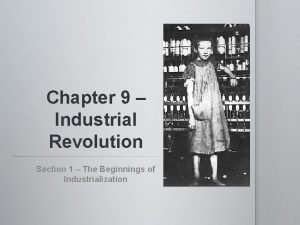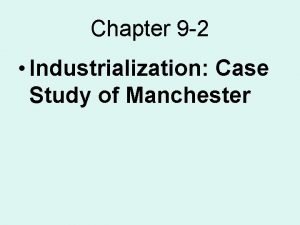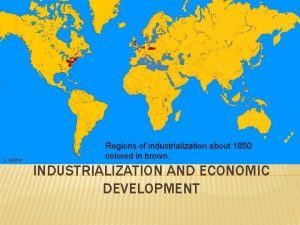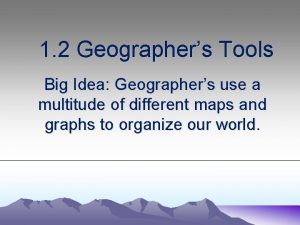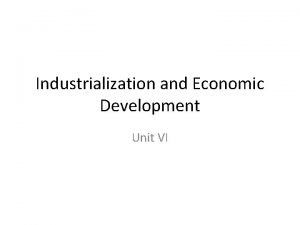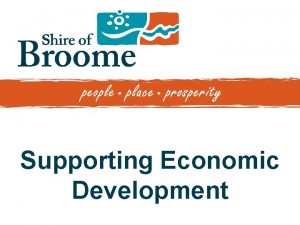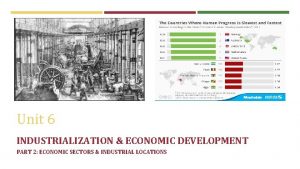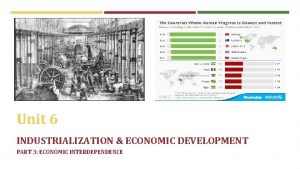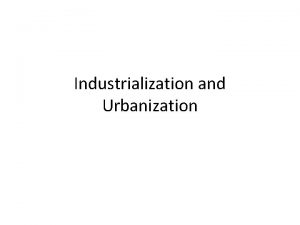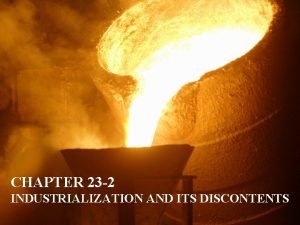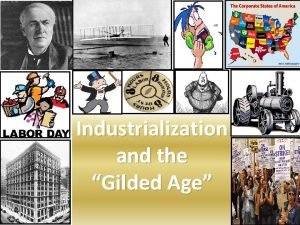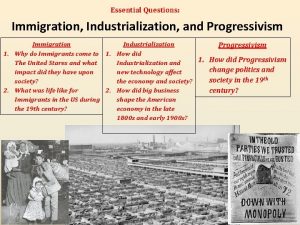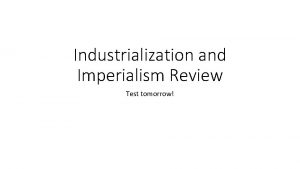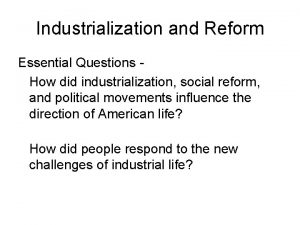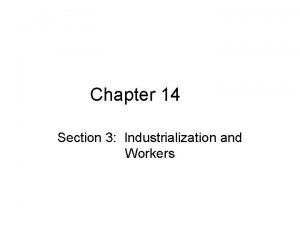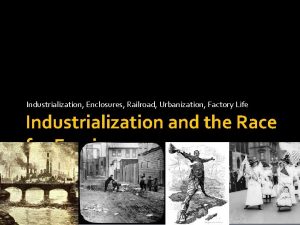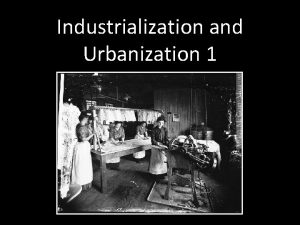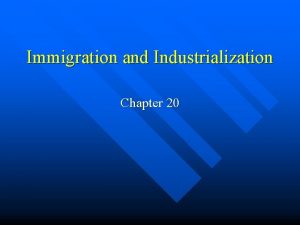Industrialization and Economic Development As economic geographers we



































- Slides: 35

Industrialization and Economic Development As economic geographers, we examine the impact of economic activity on the landscape; we investigate the reasons behind the location of economic activity; and we’re interested in the changes industrialization has brought to the cultural landscape.

Industrialization is the process by which economic activities on the earth’s surface evolved from producing basic, primary goods to using factories for mass-producing goods for consumption.

Levels of economic activity (a review!) extractive primary or ________ sector industry secondary or __________ Service or post-industrial tertiary or ___________ quaternary: research and development, management and administration, processing and disseminating information

More Developed Countries (MDCs) have experienced industrialization Less Developed Countries (LDCs) have NOT experienced industrialization or are newly industrializing countries Compressed modernity: rapid economic and political change that transformed the country into a stable nation with democratizing political institutions, a growing economy, and an expanding web of nongovernmental institutions.

Economic development can be measured through a number of ways: 1. Gross Domestic Product (GDP) is the total value of goods and services produced in a country in a year. (GDP per capita)

2. Types of jobs: primary LDCs have more jobs in the ________ sector, while tertiary MDCs have more jobs in the _______ sector.

3. Worker productivity Workers in MDCs are more productive because they have access to more machines, tools, and equipment to perform their work.

4. Access to raw materials Development requires access to raw materials, such as minerals and trees, which can be transformed into useful products.

6. Availability of consumer goods MDCs not only have enough wealth for essential goods and services, but they also have money for nonessentials.

Economic development is often accompanied by social development: high literacy rates access to formal education good health care

Theories of Economic Development 1. Modernization (or Westernization) Model Any country can grow up to be developed Tradition is the greatest barrier to modernization

Rostow’s Modernization Model Five stages: 1. Traditional: people build their lives around families, local communities, and religious beliefs. nothing much ever changes most are subsistence farmers

2. Preconditions for take-off stage Progressive leadership moves the country toward greater flexibility, openness, and diversification.

3. Take-off Stage Produce goods for trade for profit Industrial revolution in country Urbanization increases Sustained growth Technological and production breakthroughs Greater individualism Increased demand for material goods

4. Drive to (Technological) Maturity Economic growth is widely accepted People focus on attaining higher living standards

5. High Mass Consumption Mass production encourages consumption of industrial products. Luxuries become necessities

Wallerstein’s Dependency Theory Capitalist world economy: Wallerstein traced economic inequality among nations to the colonial era when Europeans first took advantage of the wealth of the rest of the world.

Three types of countries according to how they fit into the global economy Core counties, semi-periphery, and periphery

Wallerstein says that the world economy benefits rich societies an harms other countries by making them dependent on the core countries. Their dependency is perpetuated by narrow, export-oriented products such as oil, coffee, and fruit.

The Industrial Revolution

Weber’s Least Cost Theory Three factors for locating an industry 1. Transportation

2. Labor

3. Agglomeration

Primary industrial regions

Key terms: Maquiladora NAFTA

Challenges for Less Developed Countries 1. Distance from Market How easy or difficult would it be for these people to get a product to market in a more developed country?

2. Inadequate infrastructure

3. Competition with existing manufacturers in other countries

Industrialization and the environment Fossil fuel reserves? ? ?

Industrial pollution

Key term: sustainable development People living today should not impair the ability of future generations to meet their needs! Irreparable harm to the environment would (of course!) compromise the earth’s future.

Possible solutions to environmental problems 1. prevention 2. technological change 3. mitigation 4. compensation

See you all next week!


 Why are geographers concerned with scale and connectedness?
Why are geographers concerned with scale and connectedness? Why are geographers concerned with scale and connectedness?
Why are geographers concerned with scale and connectedness? Difference between economic growth and economic development
Difference between economic growth and economic development Geographers tools
Geographers tools Krono original
Krono original Why do geographers call arabia a crossroads location
Why do geographers call arabia a crossroads location Map type
Map type Geographers tools
Geographers tools Why do geographers use population pyramids
Why do geographers use population pyramids 3 major branches of christianity
3 major branches of christianity What basic questions guide geographers
What basic questions guide geographers How geographers look at the world worksheet answers
How geographers look at the world worksheet answers Economic growth vs economic development
Economic growth vs economic development Revolution
Revolution Guided reading activity industrialization and nationalism
Guided reading activity industrialization and nationalism Chapter 10 industrialization and nationalism
Chapter 10 industrialization and nationalism Chapter 10 lesson 1 the industrial revolution
Chapter 10 lesson 1 the industrial revolution Under imperialism the stronger nation attempts to
Under imperialism the stronger nation attempts to Social darwinism industrial revolution
Social darwinism industrial revolution Human capital education and health in economic development
Human capital education and health in economic development Economic growth and development
Economic growth and development Swodf
Swodf African institute for economic development and planning
African institute for economic development and planning Import substitution industrialization
Import substitution industrialization Industrialization definition
Industrialization definition Industrialization definition ap world history
Industrialization definition ap world history Least cost theory
Least cost theory Industrialization spreads chapter 25 section 3
Industrialization spreads chapter 25 section 3 Industrialization spreads chapter 9 section 3
Industrialization spreads chapter 9 section 3 Chapter 9 section 3 industrialization spreads answer key
Chapter 9 section 3 industrialization spreads answer key Footloose industries example
Footloose industries example Chapter 3 lesson 1 the rise of industry answers
Chapter 3 lesson 1 the rise of industry answers Result of industrialization
Result of industrialization American laws
American laws Chapter 9 the industrial revolution
Chapter 9 the industrial revolution Industrialization case study manchester
Industrialization case study manchester
